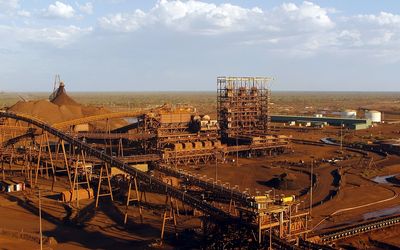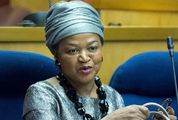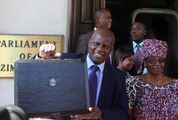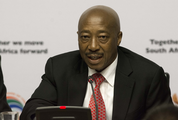Fortescue sets its sights beyond China
by David Stringer and Rebecca Keenan,
2016-03-23 05:41:33.0
AFTER inking a surprise joint venture deal with the world’s top iron-ore producer, Fortescue Metals Group is setting its long-term sights beyond China, its biggest customer and the world’s top customer.
The tie-up of Australian billionaire Andrew Forrest’s company with Vale amounts to the emergence of a new iron-ore power bloc, according to Macquarie Group. The accord, which allows for the Brazilian company to buy a minority stake in Fortescue and invest in existing or future mines, may help the world’s fourth-biggest producer eventually push into new markets to the west of China, according to CEO Nev Power.
Fortescue’s latest deal is another unexpected twist in the company’s roller-coaster history since 2003 that has been marked by disputes with regulators, governments and rivals, multiple debt and investor dramas and share price gyrations. The Vale pact was sealed this month after about a year of talks initiated by Mr Forrest against a backdrop of slowing demand in China, the biggest buyer of iron ore.
"In the most difficult circumstances, he’s always ready to pull another rabbit out of the hat," says Philip Kirchlechner, previously Fortescue’s head of marketing from June 2003 to May 2006. The pact is "quite a sophisticated idea because it is doing something more strategic and visionary".
The accord partners, whose first priority is an ore blending joint venture in China, also have an eye on developing a pipeline of projects that could eventually feed steel demand driven by the demographic change likely to sweep through Central Asia to the Middle East, Fortescue’s Mr Power said on March 15 in an interview.
"We will be monitoring the market to look at what the demand curve looks like," Mr Power said. "While we are very focused on China and the developed regions of Asia at the moment, to the west of China we have all of central Asia, India and the ’stan countries, the Middle East and even Northern Africa, which is within a very efficient and competitive sea distance from Western Australia."
Mr Forrest founded Fortescue to tap China’s rapid industrialisation even as larger rivals missed early indicators of a boom that saw crude steel production soar 12-fold between 1990 and 2014 as millions of people moved to cities and drove demand for homes, roads, cars and appliances.
From 2009 to2015, Fortescue expanded full-year shipments six-fold, a faster rate than any other major supplier in a frantic dash to meet China’s hunger for imports. The producer’s stock surged by more than 40,000% between the renaming of a predecessor company in 2003 through to a mid-2008 peak, the period when it sent a maiden shipment of 180,000 metric tonnes aboard the Heng Shan to China’s Baosteel Group.
"Their self-belief is very strong and they have a really good operating team," says Morgan Ball,MD of iron-ore producer BC Iron. Fortescue and BC Iron in December suspended a joint venture with a capacity of 6-million tonnes a year because of lower prices. "They are pretty innovative, they think about things differently," Mr Ball says.
Rio Tinto Group and BHP Billiton, the second-and third-biggest iron-ore exporters, are continuing to boost volumes amid a supply glut — a strategy that’s been criticised by Mr Forrest. The Vale pact will focus on raising realised prices by melding Brazilian and Australian ores and on winning market share at larger Chinese mills.
Investors have been tested. Roiled by the global financial crisis, Fortescue plunged 74% through 2008, then faced pressure in 2012 as prices tumbled and it risked breaching its debt covenants. The producer cut jobs, halted the development of mine and port projects and raced to secure $4.5bn of loans in September that year to push out maturities and avert any catastrophe.
When prices collapsed again through 2014, Fortescue slashed full-year spending plans by half, paused development of a processing plant and focused on lowering costs of production and trimming its debt pile. Even after pulling a $2.5bn bond deal in March last year, the company sold $2.3bn of secured bonds a month later and cut its net debt to $6.1bn by December 31, compared to $8.6bn two years earlier.
"There’s been a great deal of scepticism for a number of reasons, but the way Fortescue has extracted itself out of various issues in the past has been extremely well managed," says Michael Bush, a Melbourne-based credit strategist at National Australia Bank. The company has outperformed expectations on lowering its production costs, and "has done an excellent job on many measures".
Bloomberg

Fortescue Metals Group Christmas Creek iron ore mine. Picture: REUTERS/JIM REGAN
AFTER inking a surprise joint venture deal with the world’s top iron-ore producer, Fortescue Metals Group is setting its long-term sights beyond China, its biggest customer and the world’s top customer.
The tie-up of Australian billionaire Andrew Forrest’s company with Vale amounts to the emergence of a new iron-ore power bloc, according to Macquarie Group. The accord, which allows for the Brazilian company to buy a minority stake in Fortescue and invest in existing or future mines, may help the world’s fourth-biggest producer eventually push into new markets to the west of China, according to CEO Nev Power.
Fortescue’s latest deal is another unexpected twist in the company’s roller-coaster history since 2003 that has been marked by disputes with regulators, governments and rivals, multiple debt and investor dramas and share price gyrations. The Vale pact was sealed this month after about a year of talks initiated by Mr Forrest against a backdrop of slowing demand in China, the biggest buyer of iron ore.
"In the most difficult circumstances, he’s always ready to pull another rabbit out of the hat," says Philip Kirchlechner, previously Fortescue’s head of marketing from June 2003 to May 2006. The pact is "quite a sophisticated idea because it is doing something more strategic and visionary".
The accord partners, whose first priority is an ore blending joint venture in China, also have an eye on developing a pipeline of projects that could eventually feed steel demand driven by the demographic change likely to sweep through Central Asia to the Middle East, Fortescue’s Mr Power said on March 15 in an interview.
"We will be monitoring the market to look at what the demand curve looks like," Mr Power said. "While we are very focused on China and the developed regions of Asia at the moment, to the west of China we have all of central Asia, India and the ’stan countries, the Middle East and even Northern Africa, which is within a very efficient and competitive sea distance from Western Australia."
Mr Forrest founded Fortescue to tap China’s rapid industrialisation even as larger rivals missed early indicators of a boom that saw crude steel production soar 12-fold between 1990 and 2014 as millions of people moved to cities and drove demand for homes, roads, cars and appliances.
From 2009 to2015, Fortescue expanded full-year shipments six-fold, a faster rate than any other major supplier in a frantic dash to meet China’s hunger for imports. The producer’s stock surged by more than 40,000% between the renaming of a predecessor company in 2003 through to a mid-2008 peak, the period when it sent a maiden shipment of 180,000 metric tonnes aboard the Heng Shan to China’s Baosteel Group.
"Their self-belief is very strong and they have a really good operating team," says Morgan Ball,MD of iron-ore producer BC Iron. Fortescue and BC Iron in December suspended a joint venture with a capacity of 6-million tonnes a year because of lower prices. "They are pretty innovative, they think about things differently," Mr Ball says.
Rio Tinto Group and BHP Billiton, the second-and third-biggest iron-ore exporters, are continuing to boost volumes amid a supply glut — a strategy that’s been criticised by Mr Forrest. The Vale pact will focus on raising realised prices by melding Brazilian and Australian ores and on winning market share at larger Chinese mills.
Investors have been tested. Roiled by the global financial crisis, Fortescue plunged 74% through 2008, then faced pressure in 2012 as prices tumbled and it risked breaching its debt covenants. The producer cut jobs, halted the development of mine and port projects and raced to secure $4.5bn of loans in September that year to push out maturities and avert any catastrophe.
When prices collapsed again through 2014, Fortescue slashed full-year spending plans by half, paused development of a processing plant and focused on lowering costs of production and trimming its debt pile. Even after pulling a $2.5bn bond deal in March last year, the company sold $2.3bn of secured bonds a month later and cut its net debt to $6.1bn by December 31, compared to $8.6bn two years earlier.
"There’s been a great deal of scepticism for a number of reasons, but the way Fortescue has extracted itself out of various issues in the past has been extremely well managed," says Michael Bush, a Melbourne-based credit strategist at National Australia Bank. The company has outperformed expectations on lowering its production costs, and "has done an excellent job on many measures".
Bloomberg





















Change: -1.27%
Change: -1.42%
Change: -1.87%
Change: -1.08%
Change: -2.01%
Data supplied by Profile Data
Change: -0.47%
Change: 0.61%
Change: -1.27%
Change: 0.00%
Change: 0.63%
Data supplied by Profile Data
Change: -0.01%
Change: 0.23%
Change: 0.25%
Change: 0.15%
Change: -0.11%
Data supplied by Profile Data
Change: -0.13%
Change: 0.00%
Change: 0.00%
Change: -0.35%
Change: -2.35%
Data supplied by Profile Data